Search the Blog
Categories
- Books & Reading
- Broadband Buzz
- Census
- Education & Training
- General
- Grants
- Information Resources
- Library Management
- Nebraska Center for the Book
- Nebraska Memories
- Now hiring @ your library
- Preservation
- Pretty Sweet Tech
- Programming
- Public Library Boards of Trustees
- Public Relations
- Talking Book & Braille Service (TBBS)
- Technology
- Uncategorized
- What's Up Doc / Govdocs
- Youth Services
Archives
Subscribe
Author Archives: Emily Nimsakont
Parks and Recreation
Now that the weather has cooled off a little bit, perhaps you are thinking of getting outside and visiting a local park. If it’s still too hot for you, you can enjoy the images of parks in Nebraska Memories instead. While parks have been an important part of many Nebraska towns, the Nebraska Memories collection is especially rich in images of Omaha’s parks.
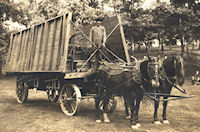 The parks of Omaha have been used for many recreational purposes, including performances. At Hanscom Park, a portable bandstand could be brought in with horses when needed for performance events. Other parks had more permanent structures, such as this pavilion in Riverview Park.
The parks of Omaha have been used for many recreational purposes, including performances. At Hanscom Park, a portable bandstand could be brought in with horses when needed for performance events. Other parks had more permanent structures, such as this pavilion in Riverview Park.

Parks also provide more informal recreational opportunities for children and adults alike. These boys are enjoying a merry-go-round in a local park, and Peony Park provides the backdrop for a game of horseshoes for this group of men.
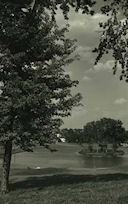 In addition to recreation, parks often serve as nature retreats in the middle of an urban landscape. The long winding drive in Miller Park and the lagoon in Fontenelle Park are just a couple examples of the beauty of nature in the middle of Omaha.
In addition to recreation, parks often serve as nature retreats in the middle of an urban landscape. The long winding drive in Miller Park and the lagoon in Fontenelle Park are just a couple examples of the beauty of nature in the middle of Omaha.
Visit Nebraska Memories to search for or browse through many more historical images digitized from photographs, negatives, postcards, maps, lantern slides, books and other materials.
Nebraska Memories is a cooperative project to digitize Nebraska-related historical and cultural heritage materials and make them available to researchers of all ages via the Internet. Nebraska Memories is brought to you by the Nebraska Library Commission. If your institution is interested in participating in Nebraska Memories, see http://nlc.nebraska.gov/nebraskamemories/participation.aspx for more information, or contact Beth Goble, Government Information Services Director, or Devra Dragos, Technology & Access Services Director.
Things Are Going Swimmingly
Are you tired of the hot July weather? Take a moment to explore these refreshing images of swimmers in Nebraska Memories.
 These women are enjoying the water at Linoma Beach, which was founded in 1924 as a “pleasure resort” halfway between Lincoln and
These women are enjoying the water at Linoma Beach, which was founded in 1924 as a “pleasure resort” halfway between Lincoln and 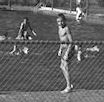 Omaha.
Omaha.
This boy is among the swimmers relaxing at the David City Municipal Pool in a 1948 photograph.
This  swimming hole at an unknown Nebraska location shows another way in which people have taken to the water for recreation.
swimming hole at an unknown Nebraska location shows another way in which people have taken to the water for recreation.
Visit Nebraska Memories to search for or browse through many more historical images digitized from photographs, negatives, postcards, maps, lantern slides, books and other materials.
Nebraska Memories is a cooperative project to digitize Nebraska-related historical and cultural heritage materials and make them available to researchers of all ages via the Internet. Nebraska Memories is brought to you by the Nebraska Library Commission. If your institution is interested in participating in Nebraska Memories, see http://nlc.nebraska.gov/nebraskamemories/participation.aspx for more information, or contact Beth Goble, Government Information Services Director, or Devra Dragos, Technology & Access Services Director.
RDA Implementation Decision
The Executives of the Library of Congress, the National Agricultural Library, and the National Library of Medicine have issued a statement regarding the implementation of Resource Description and Access (RDA).
According to the statement, “the Coordinating Committee recommends that RDA should be implemented by LC, NAL, and NLM no sooner than January 2013.” The decision is also contingent upon the completion of, or significant progress toward the completion of, some particular tasks and action items.
The full Report and Recommendations of the U.S. RDA Test Coordinating Committee will be available before the ALA Annual Conference on the Library of Congress Testing Resource Description and Access Home Page. An executive summary of the report is available now in PDF format. A statement from the executives of the LC, NLM, and NAL is also available in PDF format.
Posted in General
Leave a comment
Wedding Bells
To celebrate the beginning of June, a traditional month for weddings, take a look at some of the images of weddings in Nebraska Memories. The celebrations range from large family gatherings to small wartime ceremonies, and they show how wedding customs have changed over the years.
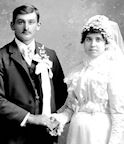
This 1902 portrait of Mr. and Mrs. Emmett Duffek is one of many wedding portraits taken by Harvey Boston, a photographer in David City. William Wentworth, an Omaha photographer, also took many wedding photographs in the 1940s, including this one at the Kelly wedding.

Visit Nebraska Memories to search for or browse through many more historical images digitized from photographs, negatives, postcards, maps, lantern slides, books and other materials.
Nebraska Memories is a cooperative project to digitize Nebraska-related historical and cultural heritage materials and make them available to researchers of all ages via the Internet. Nebraska Memories is brought to you by the Nebraska Library Commission. If your institution is interested in participating in Nebraska Memories, see http://www.nlc.state.ne.us/nebraskamemories/ for more information, or contact Beth Goble, Government Information Services Director, or Devra Dragos, Technology & Access Services Director.
Nebraska Marble
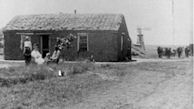
In 1862, the United States Congress passed the Homestead Act, which turned over large amounts of public land to private citizens. Homesteaders were able to claim 160 acres of land and were required to make improvements to the land, which included building a house on it within six months. On the Great Plains, where trees were scarce, many homesteaders built homes out of sod, which was jokingly called “Nebraska marble.” For more information on sod houses, explore these resources from the Smithsonian Institution or NebraskaStudies.org.
The house on the homestead of Herman Staberg is one example of a residence made of sod. Sod was not only used for houses, but for other buildings as well. This school in Cheyenne County and this church in Funk were both made out of sod. 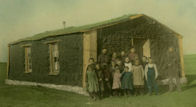
More images of sod buildings can be seen in Nebraska Memories.
Visit Nebraska Memories to search for or browse through many more historical images digitized from photographs, negatives, postcards, maps, lantern slides, books and other materials.
Nebraska Memories is a cooperative project to digitize Nebraska-related historical and cultural heritage materials and make them available to researchers of all ages via the Internet. Nebraska Memories is brought to you by the Nebraska Library Commission. If your institution is interested in participating in Nebraska Memories, see http://www.nlc.state.ne.us/nebraskamemories/ for more information, or contact Beth Goble, Government Information Services Director, or Devra Dragos, Technology & Access Services Director.
Posted in General, Information Resources, Nebraska Memories, Technology
1 Comment
Introduction to Metadata workshop scheduled for July
Description: Dublin Core, EAD, MODS, METS – it’s easy to feel overwhelmed when thinking about all the metadata standards used in today’s libraries. Attend this workshop for an introduction to the basic principles of metadata and how it is used to provide description of and access to information. Participants will have the opportunity to complete hands-on exercises using a variety of metadata standards.
This workshop is approved for the NLC Cataloging Certificate Program.
Audience: Library staff with some knowledge of cataloging.
Date: July 21, 2011
Time: 9 AM-4 PM (Central Time)
Location: Nebraska Library Commission, Lincoln
Cost: No Charge
To register, go to the Nebraska Library Commission Training Portal.
Posted in Education & Training
Leave a comment
Re-Shaping Omaha
When Omaha was founded, it looked very different from the city we know today. In the late 1800s and early 1900s, the streets of Omaha underwent a series of re-grading projects that drastically changed the city’s landscape. The level of the streets was lowered in some areas and raised in others. For example, in the late 1800s, at 17th and Farnam, the streets were lowered by 45 feet, and the dirt from this area was used to raise the grade between 20th and 24th Streets. Most buildings in the affected areas were moved to the new street level. Among the reasons for the re-grading, particularly in the later projects, was the need to make it easier for automobiles to navigate the steeply graded streets. In 1917, Dodge Street was re-graded from a 12% to a 7% grade so that cars would be able to more easily reach the top of the hill at 24th and Dodge Streets. (Source: National Register of Historic Places Registration Form for The Logan)
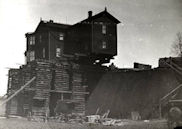
The Falconer residence, located at 1821 Douglas Street, was one of the buildings affected by street re-grading in the late 1800s. This series of photographs shows several images of the movement of the house, including a picture of it settled in its new position. Several other photographs of street re-grading work can be viewed in Nebraska Memories.
Visit Nebraska Memories to search for or browse through many more historical images digitized from photographs, negatives, postcards, maps, lantern slides, books and other materials.
Nebraska Memories is a cooperative project to digitize Nebraska-related historical and cultural heritage materials and make them available to researchers of all ages via the Internet. Nebraska Memories is brought to you by the Nebraska Library Commission. If your institution is interested in participating in Nebraska Memories, see http://www.nlc.state.ne.us/nebraskamemories/ for more information, or contact Beth Goble, Government Information Services Director, or Devra Dragos, Technology & Access Services Director.
Assigning Library of Congress Subject Headings offered online, May 2- June 5
Description: Subject headings are important access points for library materials. The assignment of subject headings depends heavily on the cataloger’s judgment and knowledge. This five-week online workshop will focus on subject analysis and the proper construction of Library of Congress Subject headings.
Audience: Library staff with some knowledge of AACR2, MARC records, and cataloging.
This workshop is approved for the NLC Cataloging Certificate Program.
This class will be held online from May 2 to June 5. Class participants will access the course web site in order to read materials, discuss issues in a forum, and complete projects and assignments. The class is held asynchronously, which means that participants are not required to be online at any particular time during the five weeks; however, there is a class schedule with due dates that participants are expected to meet. The instructor will interact with the participants during the course to offer feedback and provide explanations of material.
To register, go to the Nebraska Library Commission’s
[obsolete link removed] Training Portal.
Posted in Education & Training
Leave a comment
Grocery Shopping Through the Years

Whether they visited a general store or a supermarket, Nebraskans have been grocery shopping for many decades. You can explore Nebraska Memories to find many images of grocery stores and their customers.
How do you think the grocery shopping experience at this Omaha store in the late 1930s or early 1940s differed from your own? (Wentworth, William, Women shopping in grocery store, The Durham Museum collection, 1930-1945)

What about shopping at this general store in the early 1900s? (Nelson, John, Family in shop, Nebraska State Historical Society collection, 1907-1917).
See other images of Nebraskans doing their grocery shopping and grocers displaying their wares.
Visit Nebraska Memories to search for or browse through many more historical images digitized from photographs, negatives, postcards, maps, lantern slides, books and other materials.
Nebraska Memories is a cooperative project to digitize Nebraska-related historical and cultural heritage materials and make them available to researchers of all ages via the Internet. Nebraska Memories is brought to you by the Nebraska Library Commission. If your institution is interested in participating in Nebraska Memories, see http://nlc.nebraska.gov/nebraskamemories/ for more information, or contact Beth Goble, Government Information Services Director, or Devra Dragos, Technology & Access Services Director.
Posted in General, Information Resources, Nebraska Memories, Technology
2 Comments
RDA Toolkit launches Wednesday, June 23
The Co-Publishers of the RDA Toolkit (American Library Association, Canadian Library Association, and CILIP–through its publishing imprint, Facet Publishing) are delighted to announce that the RDA Toolkit is going live Wednesday, June 23.
If you have already signed up for free open access, you will receive an email with your login information. For institutional access, an email with login information will be sent to the email address provided during sign-up.
RDA Toolkit highlights to try:
• RDA instructions that are searchable and browseable
• AACR2 Rule Number Search of RDA instructions
• Workflows, mappings: tools to customize the RDA instruction set to support organizational training and processes.
• Two views of RDA content-by table of contents and by element set
• Full text of AACR2
If you or your institution haven’t yet signed up for free open access through August 31, 2010, please visit www.rdatoolkit.org/openaccess.
Sign up at www.rdatoolkit.org/rdalist to receive information about free trials, special introductory offers (double-user offer for site license subscriptions through August 31, 2011!), webinars, product updates, and more.
Bookmark the informational website www.rdatoolkit.org where you can access webinar archives, an RDA training calendar, presenter/trainer materials, pricing in the major currencies, and more.
Posted in General
Leave a comment
OCLC-MARC Bibliographic, Authority, and Holdings Formats Update 2009
On Sunday, August 16, 2009, OCLC implemented the changes related to the OCLC-MARC Bibliographic, Authority, and Holdings Formats Update 2009. Among the points of interest:
o Defining Videorecording 007/04 (subfield $e) code “s” for Blu-ray Discs.
o Linking ISSNs (ISSN-L) in bibliographic, authority, and holdings fields 022.
o Changing field 041 to separately subfield subtitles/captions for moving images (subfield $j).
o Validating codes for subfield $2 in field 047 (musical form) and 048 (medium of performance) for the respective code lists maintained by IAML (International Association of Music Libraries).
o Implementing two new Dewey fields: 083 (Additional Dewey Decimal Classification Number) and 085 (Synthesized Classification Number Components).
o Implementing the repeatable 260 field.
o Making field 440 obsolete and converting appropriate 4XX/8XX combinations.
o Defining new subfields in field 502 for dissertation details (degree, school, date, etc.).
o Implementing new field 542 for Information Relating to Copyright Status.
o Implementing subfield $0 (zero) for the Authority Record Control Number in 28 bibliographic fields and three authority fields.
The following changes will occur in Connexion browser and Connexion client:
Connexion browser:
o Connexion browser users have changes to the dropdown lists for fixed field elements available for use immediately.
o The National Bibliography Number index (“nn:”) will not appear in the Connexion browser dropdown list until November 2009. In the meantime, it is available via the command line in Connexion browser. All other new indexes and new or changed language qualifiers appear in search screen dropdown lists.
Connexion client:
o Beginning on Tuesday, August 18, 2009, Connexion client users will be prompted when they start the Connexion client software to download a new file with changes to the dropdown lists for fixed field elements. The window with the prompt is labeled “New Components Available.” You do not need Administrative Privileges on your workstation to download the file. Say “Yes” to download the file immediately. Say “Remind me later” if you do not wish to download right away. You will be prompted to download the file each time you open Connexion client until you complete the download.
o In Connexion client, all new indexes and new or changed language qualifiers do not appear in search screen dropdown lists, but may be input manually via the command line. The search screen dropdown lists of indexes and language qualifiers will be updated in the next version of the Connexion client.
If you have any questions about these changes, consult OCLC Technical Bulletin 257, which presents the details.
Posted in General, Technology
Leave a comment
How Are You Celebrating El Día de los Niños / El Día de los Libros in April?
El Día de los Niños / El Día de Los Libros (Children’s Day / Book Day) is April 30
What is Día? According to children’s author Pat Mora’s Website, Día is a daily commitment to link all children to books, languages, and cultures. It was founded in 1996 by author Pat Mora who was enthusiastically and creatively assisted by REFORMA, the National Association to Promote Library and Information Services to Latinos and the Spanish Speaking. Día is now housed with the American Library Association (ALA) and the Association for Library Service to Children (ALSC). Culminating Día celebrations are held across the country on or near April 30th.
Libraries across the Nebraska and the nation are celebrating Día…are you?
Be sure to register with the ALA and ALSC and post a comment to this blog entry to announce your participation or efforts.
Do you have an event, programming, or awareness campaign in place?
Día is an opportunity to celebrate bilingual literacy and diversity with your entire community. As you reach out to the Spanish-speaking community in particular, your library can also promote where your library is, your Spanish-language collections, Internet access, ease of signing up for a library card, your friendly, helpful staff, or the library as a place for the whole family to spend time together.
Whether you have a full day of activities planned, a brochure to hand out, or a press release, please share how you are making an effort to say that you celebrate children and bilingual literacy in your community.
Posted in Public Relations, Youth Services
1 Comment

